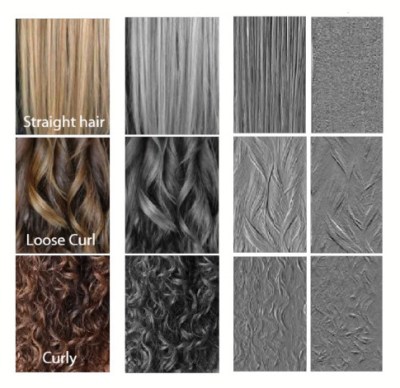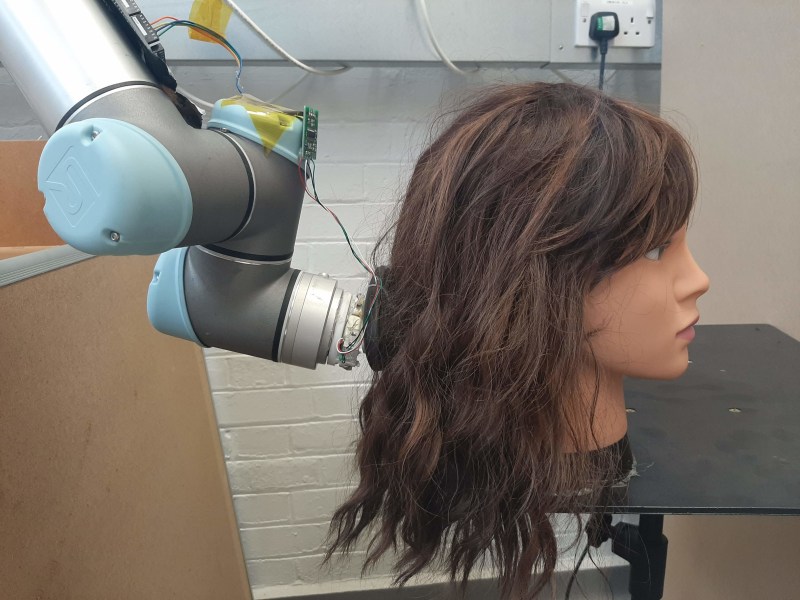Whether you care to admit it or not, hair is important to self-image, and not being able to deal with it yourself feels like a real loss of independence. To help people with limited mobility, researchers at MIT CSAIL have created a hair-brushing robot that combines a camera with force feedback and closed-loop control to adjust to any hair type from straight to curly on the fly. They achieved this by examining hair as double helices of soft fibers and developed a mathematical model to untangle them much like a human would — by working from the bottom up.
 It may look like a hairbrush strapped to a robot arm, but there’s more to it than that. Before it ever starts brushing, the robot’s camera takes a picture that gets cropped down to a rectangle of pure hair data. This image is converted to grayscale, and then the program analyzes the x/y image gradients. The straighter the hair, the more edges it has in the x-direction, whereas curly hair is more evenly distributed. Finally, the program computes the ratio of straightness to curliness, and uses this number to set the pain threshold.
It may look like a hairbrush strapped to a robot arm, but there’s more to it than that. Before it ever starts brushing, the robot’s camera takes a picture that gets cropped down to a rectangle of pure hair data. This image is converted to grayscale, and then the program analyzes the x/y image gradients. The straighter the hair, the more edges it has in the x-direction, whereas curly hair is more evenly distributed. Finally, the program computes the ratio of straightness to curliness, and uses this number to set the pain threshold.
The brush is equipped with sensors that measure the forces being exerted on the hair and scalp as it’s being brushed, and compares this input to a baseline established by a human who used it to brush their own hair. We think it would be awesome if the robot could grasp the section of hair first so the person can’t feel the pull against their scalp, and start by brushing out the ends before brushing from the scalp down, but we admit that would be asking a lot. Maybe they could get it to respond to exclamations like ‘ow’ and ‘ouch’. Human trials are still in the works. For now, watch it gently brush out various wigs after the break.
Even though we have wavy hair that tangles quite easily, we would probably let this robot brush our hair. But this haircut robot? We’re not that brave.















If only I had hair.
Save on robots.
Nobody said the hair had to be on your head.
Nothing like tangled hair can ruin your day when the robot apply full force without some kind of force sensing/limiting.
Universal Robots models like the UR5 do have rather sensitive feedback on the drivers, and is one of the platforms main selling points. There is a tear down of some parts of their drives posted on youtube, and as a platform these seem fairly performant.
However, unless the inventors demonstrate their work personally… no one is going to trust this contraption.
For some reason it reminds me of Red Dwarf, Season 2:Episode 1, “Kryten”
;-)
Or of the machine that did Thor’s haircut.
so, why does an MIT/Harvard project take place in a facility with UK electric receptacles?
Some labs have those for 240V
Do you have an example? I ask because I’ve visited literally hundreds of labs in dozens of universities in the USA (including several at MIT). Not once have I seen a UK type receptacle there. 240V in larger buildings is rare, usually requiring a dedicated transformer. More usually, it’s 3-phase 208V, using something like an L15 connector. If 240V really is required, it’s using either a NEMA6 or a some higher current connector, like a residential dryer receptacle. As a rule (probably literally) a UK receptacle is never found.
The first version kept trying to sniff the hair. They shut it down so it wouldn’t run for president… 😄😄😄😄
I dare say Simone Giertz has a lead on this by a few years, say circa 2016: https://www.youtube.com/watch?v=gTfPkfE1Lxk
Nice try… But there is such a long way to go
For a research presentation I would expect human trials, at least for the video. This gives the impression that even the creators were not convinced of their system to try it on them/their friends.
Bonus for time lapse with results of successful brushing of hair that needs brushing.